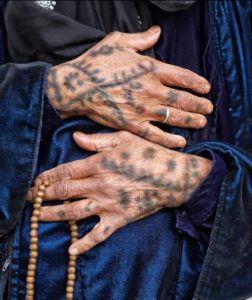Al Washim
Al Washim (tattooing) is one of the most important means of cosmetics and beautification among Bedouin women. There are specialized women who excel in the art of tattooing. It is a profession through which they earn income. Tattoos are engraved on the face This practice became widespread among women in the past.
This tradition was famous in the past. Tattooing on the face or hands involves specific shapes and designs created using a needle dipped in a mixture of charcoal or oven soot. The needle is used to prick the skin according to the desired pattern of the tattoo. After the tattooed area heals, a greenish mark or hands using a needle, kohl, or a similar substance appears.
During the tattooing process on the face or any other part of the body, the desired shape is first outlined using charcoal powder or “shahar.” Then, the designated area is pricked with the needle.
Some women prefer the “Siyal” tattoo, which consists of lines near the cheekbone or between the eyebrows. Others prefer dots to adorn their cheeks, while some women like the “Rada” tattoo, which is in the shape of a rose. There is also the tattoo in the shape of swords.
Different Names of Tattooing Styles:
There are various types of tattoos with their respective names. For instance, the “Dathamah” tattoo is located at the edge of the lip. The “Zalfa” and “Nuqtah” tattoos are placed on the cheek. The “Kuhl al-Qita” tattoo is at the edge of the eye, and the “Hilal” tattoo is between the eyebrows.
Tattooing is not only considered as adornment, but also is used for medicinal purposes, particularly for joint pain. There is a type of tattoo called “Halabat” that is applied around the wrist to treat hand pain. Shapes can also be drawn on the ankles, and there is the “Hajoul” tattoo located on the lower leg.


